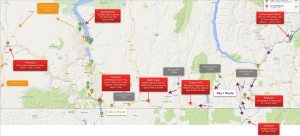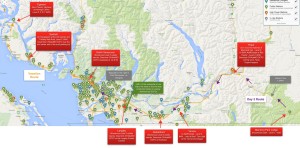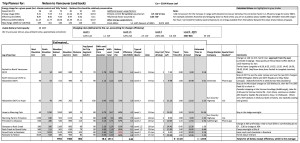Introduction
In May I received an invitation to a workshop to help plan future deployment of Level 3 DCFC infrastructure in BC. The workshop was to take place in mid June in Vancouver and hosted by PlugInBC. The workshop was to include representatives from government, educational institutes, BC Hydro, various EVSE network service providers and several other EVangelists. I was invited to provide some perspective from outside of the Lower Mainland and was extremely excited about the prospect of attending. I immediately went into planning mode and floated the trip by Marley later that evening – I could either do the trip by myself, attending the workshop on Monday and getting home late Tuesday night (or heading straight to work in Trail on Wednesday morning), or we could move some of our holiday plans around to allow her and the kids to come as well… and of course we would have to do the trip in our EV! It would have been crazy to drive our gas car to attend a workshop on DCFC infrastructure – I couldn’t pass up an opportunity to explore the current state of Level 2 and DCFC infrastructure in the various regions of BC! (click here for an explanation of Level 2 vs DCFC and visit PlugShare to explore what infrastructure is available in BC currently)
After some preliminary planning, Marley was totally on board with the idea of joining with the kids for a trip that would be part work and part fun. The kids like to stop frequently anyways, so the idea of charging every 1 – 1.5 hours for a few hours wasn’t really daunting. Investigating what to do for a few days in the area after the workshop on Monday, we thought of the Sunshine Coast. We had always wanted to explore the Sunshine Coast but had not made it over there while attending UBC or on subsequent vacations from Northern BC to the coast region. I had noticed the existence of a DCFC in Sechelt and how it was the endpoint of a corridor of DCFCs from Abbotsford to the Coast, so that settled it. The idea of completing a trip that encompassed two fundamentally different types of charging would provide a stark comparison of the reality (as of June 2015) of long-distance travel via Level 2 chargers vs the future: the expanding network of DCFCs!
With that, the idea of ‘two journeys’ was born – the first would be utilizing a combination of Level 1 and Level 2 charging and would require fairly extensive planning with my spreadsheet tool (refer to this post for a brief explanation); the second would be more off the cuff and much less planned. The second was actually harder for me; after getting used to the idea of planning my trips out to the hour, the thought of being spontaneous was actually a bit scary! I did check the ferry sailing times and how long it would take to get from one place to another to ensure we didn’t miss a sailing, but I would have done that anyways in our gas car. The extent of “EV planning” for this portion of the trip was to check the distances between the various DCFCs and realizing I could skip charging at a few of them since some of them are relatively close together and were on our route more or less.
Planning the First Journey
Looking at my initial planned trip involved twiddling our thumbs for an additional 8 hours of daytime Level 1 charging split between Grand Forks and an RV park near Rock Creek vs what the trip would be like with Level 2 chargers between Rossland and Osoyoos. Some sleuthing turned up that there was multiple RV parks along this route that had 240V/50A service available, and with a unit such as an EVSE Upgrade or an Open EVSE, I would be able to charge at the full 6.6kW of which my car is capable. After some discussion with Marley, we determined that we would likely use a portable 240V charger on future trips around the Kootenays and into the northern US states since the public charging infrastructure is not very developed yet in our region. Offsetting the cost of the unit would occur over a number of years from leaving the Subaru at home for trips that we might have done with it instead. So, a bit last minute, we placed our order for the Open EVSE and kept refining our plan for the trip.
The initial trip plan included stopping in Castlegar on our way to Grand Forks instead of what I had done for previous trips, which was to go to Rossland – I had reached out to the Castlegar GM dealer about using their charger, to which they graciously agreed, and which I estimated was going to save us 2.5 – 3 hours of trip time! I had originally planned to go directly from Osoyoos to Princeton, but my planning sheet showed that as consuming 97% of battery, so some looking around showed a cool back-road from Summerland to Princeton, with a restored steam train on the historic Kettle Valley Railway as a neat activity for the kids while charging!
As the departure day grew closer, our Open EVSE had still not arrived… and I was getting anxious! Re-jigging our trip around only having Level 1 charging at the RV campgrounds was going to mean changing reservations at campgrounds and add a number of hours to our trip – the domino effect is huge when you have to unexpectedly use Level 1 charging because of how slow it is to “trickle charge”, even compared to charging at Level 2 (>15 hours for a full charge vs 3 hours!) As it turns out, UPS had given a wildly optimistic shipping time originally, and the charger wasn’t slated to arrive in Northport, WA until the Friday we planned to leave (it was supposed to arrive the prior week and I was going to pop over the border after work and pick it up). That meant a detour on Friday south to Rossland, charging in Rossland, then crossing the border to Northport, picking up the unit, then back to Rossland for more charging before finally rejoining our original planned route on Highway 3 near Nancy Greene Lake – in total the detour looked to add an additional 4.5 hours of travel and charging time (2.5 hours of which was charging).
See the table below for the trip summary – for a more detailed view, click on the spreadsheet screenshot below and it will enlarge. Click the map to view our planned trip graphically. One thing you will notice is that we didn’t plan the trip around driving slow (unlike what I did in Part 3 of the Kelowna trip) – we wanted to travel on the highway with the flow of traffic or at the speed limit.
| Starting Town | Destination | Distance (km) | Driving Time (hrs) | Charge Time at Destination (hrs) | Comments |
| Nelson | Rossland | 80 | 1:15 | 2:30 | Charge at Washington St parking lot, Level 2 |
| Rossland | Rossland | 50 | 1:30 | 1:30 | Cross the border to Northport, WA; pick up the Open EVSE and cross back over to Canada, charge again |
| Rossland | Grand Forks | 105 | 1:15 | 1:30 | Charge at RV campground, 50A service |
| Grand Forks | Rock Creek | 70 | 1:00 | 3:00 | Camp overnight, 50A service |
| Day 1 Totals | 305 | 5:00 | 5:30 | Only daytime charging included in total | |
| Rock Creek | Osoyoos | 60 | 0:45 | 1:00 | Charge at Gyro Park, Level 2 |
| Osoyoos | Summerland | 80 | 1:00 | 3:00 | Charge at Municipal Hall, Level 2. Take kids on cool steam train! |
| Summerland | Princeton | 95 | 2:00 | 2:00 | Take back road, Princeton-Summerland Road (mostly gravel, but well maintained); charge at Tourism Info Center, Level 2 |
| Princeton | Manning Park | 70 | 1:00 | 12 – 13 | End Day 2; camped at Coldspring Campground; car charged at Manning Park Lodge, ~2km walk away; charge overnight on Level 1 |
| Day 2 Totals | 305 | 4:45 | 5:00 | Only daytime charging included in total | |
| Manning Park | Hope | 70 | 1:00 | 1:15 | Begin Day 3; charge at Municipal Hall, Level 2 |
| Hope | Abbotsford | 85 | 1:00 | 0:25 | Charge at our first DCFC at the EcoDairy! |
| Abbotsford | Downtown Vancouver | 80 | 1:30 | …. | End Day 3; Charging where? I said we didn’t plan this part, remember? JAs you can see, our total travel time on Day 3 was actually going to be pretty short. |
| Day 3 Totals | 235 | 3:30 | ~ 1:45 | Only daytime charging included in total |
Coincidentally, Sun Country Highway was running the annual EV “E-mazing Race” – a country-wide event where participants have about 1 month to visit as many SCH chargers as they can, receiving points for each station where they check-in. I had a look at the SCH charger map and selected a number that were on our route that we would visit if we could, so I registered as a participant (click on figure below to enlarge).
Planning the Second Journey
As mentioned earlier, I really didn’t plan this leg of the journey that much – the whole point was to see what it was like to travel utilizing DCFCs only, which would be sort-of mimicking how we travel in gasoline cars today (though I would have to stop and “fuel” more often).
| Starting Town | Destination | Distance (km) | Comments |
| Vancouver | Sechelt | 80 | Charge at North Vancouver DCFC on our way to the ferryFerries leave Horseshoe bay at 7:20, 9:25, 11:30, 13:35, 15:50, 17:50, 19:50, 21:45 |
| Sechelt | To Egmont, then back to Sechelt | 120 | Hike Skookumchuck, check-in at the Egmont SCH charger! Charge while hiking. |
Yep, that is all we planned out! We didn’t even pre-book at a campground, though we did look up a few prior to leaving and thought we would want to stay close to Sechelt, probably at Porpoise Bay Provincial Park. Other than that, we would head over either on Monday night after the workshop (which went from 10 am – 3 pm in downtown Vancouver), or Tuesday morning, then spend all of Tuesday, Wednesday and Thursday exploring the area around Sechelt before catching the ferry back to the mainland on Friday to start the journey home. (Click the map to check out the planned trip graphically.)
Planning the Final Leg
The final leg was really a continuation of the first journey; copious amounts of planning to determine where we would stay each night and what time we might arrive. We would stay at Manning Park Lodge on the way home (this time actually in the Lodge), and instead of staying at the RV park near Rock Creek, we would charge there briefly prior to heading to Grand Forks to stay the night at the RV park we had only stopped at the previous week. Click the screenshot below to see the spreadsheet in a larger size.
I also wanted to stop at the BCIT Solar Canopy… and for good measure, we threw in the wild-card of a planned trip to Ikea on Friday June 19… and as you’ll read later, that stop, plus the general craziness of leaving the Lower Mainland on a Friday afternoon made for a bit of a long day! The plan had us arriving back in Nelson on Sunday afternoon, at about 4:30 pm.
Trip summary (and photos!) coming in Part Two (now posted!)…
- R1T Efficiency Tests: Bikes and Ski Boxes - March 30, 2024
- Adding Outdoor Accessories to my R1T - December 1, 2023
- Why an EV truck? Why the R1T? - October 8, 2023






I enjoy your level of detail and looking forward to your posts. We just got home from Osoyoos in the Tdi. Sometime we will take the leaf.
David, thanks for your comment. I’m glad that this information is useful to people! Once the DCFC infrastructure is filled in between Hope and Osoyoos, taking the Leaf should be no problem 🙂
Andrew, what tools are you using for your elevation gain/drop figures in your planning charts and how are you estuarine the kWh used for the legs of your travel?
We are planning a trip to the Seattle zoo in the leaf.
Thanks
David
David, I have some of that info posted in Parts 1 and 3 of my trip to Kelowna series of blog posts; however, I think I will make a separate dedicated Page and include a demonstration Excel file.
Pingback: A Tale of Two Journeys – Part Two | Kootenay EV Family